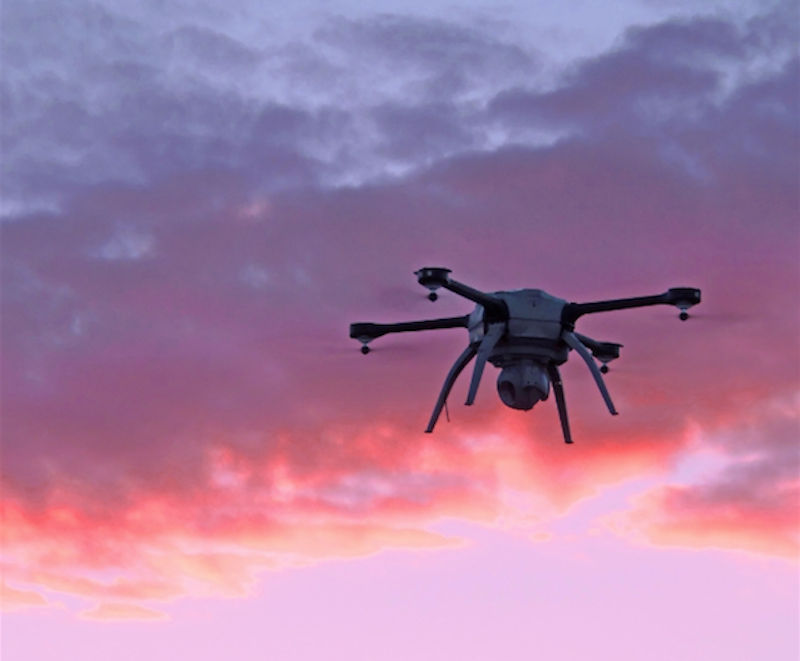Drones can often times be unfairly judged. When people hear the ominous buzzing of a rotary wing drone overhead and look up to see it silhouetted against the sun, it can be easy to hear “Flight of the Valkyries” start playing in your head and think the NSA is coming to get you. And while safety and privacy issues are certainly of concern when it comes to operating drones, what is often times disregarded is just how useful UAVs (unmanned aerial vehicles) can be.
The SkyBEAM (Building Envelope Aerial Mapping) UAV, from Tremco Roofing & Building Maintenance, developed by Industrial SkyWorks, is a perfect example of how a drone can be utilized as a tool for cutting costs and improving workplace safety for certain jobs. The SkyBEAM UAV combines the use of a high-definition camera and a thermographic (infrared) camera to fly around buildings and locate where there may be energy leaks, damage, deterioration, safety issues, or other potential problems. The thermographic camera shows temperature variations around a building that may indicate problems, such as poor or missing window sealing or wet rooftop insulation, so that the issues may be fixed. If not rectified, issues such as these can add up to significant capital expenses, increased operating costs, and occupant discomfort.
This type of infrared scanning is most effective at night when the sun is not warming the building. In the past, technicians would climb the rooftops at night to conduct their infrared scans. Façade inspections meant technicians needed to work from scaffolding or cranes, both of which would lead to added costs and safety concerns. But now, since the SkyBEAM has become the first commercial drone approved by the FAA for nighttime operation, these expenses and safety concerns can be eliminated.
A two-person crew, one of which is a licensed pilot, operates SkyBEAM from the ground. The UAV can fly horizontally across roofs and can reach heights of 400 feet (or about 40 stories) while retaining its flight path in winds up to 25 mph and gusts up to 50 mph. SkyBEAM has a top speed of 25 mph.
Ideal for low-slope roofing and façade diagnostics on multi-building campuses such as educational institutions and healthcare facilities, SkyBEAM’s high-resolution camera can map problem areas of a building such as gaps or tears in the roof, tiny cracks or movement in the façade, and deteriorating concrete.
All of the information from SkyBEAM’s two cameras is then consolidated into a comprehensive, interactive, and easy-to-understand report that can be accessed through a cloud-based application. The software creates a virtual model of the building in 2D and 3D that can be viewed from any angle, be overlaid with thermal images to their exact location, and can have photographs, comments, and other data added in real time through a tablet so technicians can always have the most up to date information. Additionally, data can be transmitted to technicians on the roof so they can always see their location in relation to the problem areas. As technicians walk across the roof, the scan moves with them so they can locate exactly where the work needs to be done.
Drones, despite the surfeit of rules and regulations regarding their use, appear to be in it for the long haul. Many companies are already experimenting with drones as a form of delivery, such as Amazon and Domino’s, and being allowed to fly after sunset would also greatly aid these companies in their visions for how to best utilize UAVs. The FAA projects more than seven million drones may be purchased over the next 15 years, and as their uses grow, such as with the SkyBEAM UAV, that number will likely grow, as well.
Just imagine watching as a drone appears on the horizon carrying your large pepperoni and cheese pizzas. What a time to be alive.
Related Stories
AEC Tech Innovation | May 12, 2023
Meet Diverge, Hensel Phelps' new ConTech investment company
Thai Nguyen, Director of Innovation with Hensel Phelps, discusses the construction giant's new startup investment platform, Diverge.
AEC Tech | May 9, 2023
4 insights on building product manufacturers getting ‘smart’
Overall, half of building product manufacturers plan to invest in one or more areas of technology in the next three years.
Sustainability | May 1, 2023
Increased focus on sustainability is good for business and attracting employees
A recent study, 2023 State of Design & Make by software developer Autodesk, contains some interesting takeaways for the design and construction industry. Respondents to a survey of industry leaders from the architecture, engineering, construction, product design, manufacturing, and entertainment spheres strongly support the idea that improving their organization’s sustainability practices is good for business.
AEC Tech | May 1, 2023
Utilizing computer vision, AI technology for visual jobsite tasks
Burns & McDonnell breaks down three ways computer vision can effectively assist workers on the job site, from project progress to safety measures.
AEC Tech Innovation | Apr 27, 2023
Does your firm use ChatGPT?
Is your firm having success utilizing ChatGPT (or other AI chat tools) on your building projects or as part of your business operations? If so, we want to hear from you.
Design Innovation Report | Apr 19, 2023
HDR uses artificial intelligence tools to help design a vital health clinic in India
Architects from HDR worked pro bono with iKure, a technology-centric healthcare provider, to build a healthcare clinic in rural India.
Resiliency | Apr 18, 2023
AI-simulated hurricanes could aid in designing more resilient buildings
Researchers at the National Institute of Standards and Technology (NIST) have devised a new method of digitally simulating hurricanes in an effort to create more resilient buildings. A recent study asserts that the simulations can accurately represent the trajectory and wind speeds of a collection of actual storms.
3D Printing | Apr 11, 2023
University of Michigan’s DART Laboratory unveils Shell Wall—a concrete wall that’s lightweight and freeform 3D printed
The University of Michigan’s DART Laboratory has unveiled a new product called Shell Wall—which the organization describes as the first lightweight, freeform 3D printed and structurally reinforced concrete wall. The innovative product leverages DART Laboratory’s research and development on the use of 3D-printing technology to build structures that require less concrete.
Smart Buildings | Apr 7, 2023
Carnegie Mellon University's research on advanced building sensors provokes heated controversy
A research project to test next-generation building sensors at Carnegie Mellon University provoked intense debate over the privacy implications of widespread deployment of the devices in a new 90,000-sf building. The light-switch-size devices, capable of measuring 12 types of data including motion and sound, were mounted in more than 300 locations throughout the building.
Architects | Apr 6, 2023
New tool from Perkins&Will will make public health data more accessible to designers and architects
Called PRECEDE, the dashboard is an open-source tool developed by Perkins&Will that draws on federal data to identify and assess community health priorities within the U.S. by location. The firm was recently awarded a $30,000 ASID Foundation Grant to enhance the tool.

















